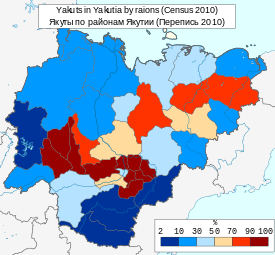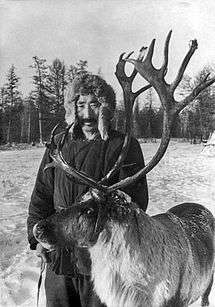Yakuts
| Total population | |
|---|---|
| 450,000–510,000 | |
| Regions with significant populations | |
| 478,085 (2010 census)[1] | |
| 2,820 (2010 census)[2] | |
| 415 (2009 census)[3][4] | |
| 304 (2001 census)[5][6] | |
| Languages | |
| Yakut, Russian | |
| Religion | |
| Predominantly Russian Orthodox Christianity, with a significant part of the population practicing Shamanism | |
| Related ethnic groups | |
| Dolgans, Mongols (Barga, Khalkha, Oirats, Khamnigans), Tuvans, Buryats, Manchu, Khakas, Altay, Kazakhs, Kyrgyz, Samis, Inuit | |

Yakuts (Yakut: Саха Sakha), are Turkic people[7] who mainly inhabit the Sakha Republic (Yakutia).
The Yakut language belongs to the Siberian branch of the Turkic languages. Yakuts mainly live in the Republic of Sakha in the Russian Federation, with some extending to the Amur, Magadan, Sakhalin regions, and the Taymyr and Evenk Autonomous Districts.
The Yakuts are divided into two basic groups based on geography and economics. Yakuts in the north are historically semi-nomadic hunters, fishermen, reindeer breeders, while southern Yakuts engage in animal husbandry focusing on horses and cattle.[8]
Origin and history

The ancestors of Yakuts were Kurykans who migrated from Yenisey river to Baikal Lake.[9][10][11] in the 7th century. The Yakuts originally lived around Olkhon and the region of Lake Baikal. Beginning in the 13th century they migrated to the basins of the Middle Lena, the Aldan and Vilyuy rivers under the pressure of the rising Mongols.

The northern Yakuts were largely hunters, fishermen and reindeer herders, while the southern Yakuts raised cattle and horses.[12][13]
In the 1620s the Tsardom of Muscovy began to move into their territory and annexed or settled down on it, imposed a fur tax and managed to suppress several Yakut rebellions between 1634 and 1642. Russian brutality in collection of the pelt tax (yasak) sparked a rebellion and aggression among the Yakuts and also Tungusic-speaking tribes along the River Lena in 1642. The voivode Peter Golovin, leader of the Russian forces, responded with a reign of terror: native settlements were torched and hundreds of other people presumably were tortured and some military personnel were killed. The Yakut population alone is estimated to have fallen by 70 percent between 1642 and 1682 because of the Grand Duchy of Muscovy expeditions.[14]
In the 18th century the Russians reduced the pressure, gave Yakut chiefs some privileges, granted freedom for all habitats, gave them all their lands, sent Orthodox missions, and educated the Yakut people regarding agriculture. The discovery of gold and, later, the building of the Trans-Siberian Railway, brought ever-increasing numbers of Russians into the region. By the 1820s almost all the Yakuts had been converted to the Russian Orthodox church, although they retained, and still retain, a number of Shamanist practices. Yakut literature began to rise in the late 19th century. A national revival occurred in the early 20th century.
In 1922, the new Soviet government named the area the Yakut Autonomous Soviet Socialist Republic. The last conflict of the Russian Civil War, known as the Yakut Revolt, occurred here when Cornet Mikhail Korobeinikov, a White Russian officer, led an uprising and a last stand against the Red Army.

In the late 1920s through the late 1930s, Yakut people were systematically persecuted, when Joseph Stalin launched his collectivization campaign.[15] It's possible that hunger and malnutrition resulting from the period resulted in a decline in the Yakut total population from 240,500 in 1926 to 236,700 in 1959. By 1972, the population began to recover.[16]
Yakut males belong to Haplogroup N3a (89%).[17]
Currently, Yakuts form a large plurality of the total population within the vast Sakha Republic. According to the 2010 Russian census, there were a total of 466,492 Yakuts residing in the Sakha Republic during that year, or 49.9% of the total population of the Republic.
Language
According to the 2010 census, some 87% of the Yakuts in the Sakha Republic are fluent in the Yakut (or Sakha) language, while 90% are fluent in Russian.[18] The Sakha/Yakut language belongs to the Northern branch of the Siberian group of Turkic languages. It is most closely related to the Dolgan language. Slightly less closely related languages include Tuvan and Shor.
Cuisine
The cuisine of Sakha consists predominantly of the traditional drink kumis, dairy products of mare and reindeer milk, sliced frozen salted fish stroganina (строганина), loaf meat dishes (oyogos), venison, frozen fish, thick pancakes, and salamat - a millet porridge with butter and horse fat. Kuerchekh [Куэрчэх] or kierchekh, a popular dessert, is made of mare milk or sour cream with various berries. Indigirka is a traditional fish salad. This cuisine is only used in Yakutia.
See also
- Aisyt (Ajysyt/Ajyhyt), the name of the mythic mother goddess of the Sakha people
- Music in the Sakha Republic
- Yakutian cattle
- Yakutian horse
- Yakutian knife
Footnotes
- ↑ "ВПН-2010". Retrieved 18 March 2015.
- ↑ "Yakuts in China". Retrieved 18 March 2015.
- ↑ "Қазақстан 2009 жылы". Retrieved 18 March 2015.
- ↑ Агентство Республики Казахстан по статистике. Перепись 2009. (Национальный состав населения.rar)
- ↑ Joshua Project. "Yakut". Retrieved 18 March 2015.
- ↑ Всеукраїнський перепис населення 2001. Русская версия. Результаты. Национальность и родной язык.
- ↑ Yakut - an ethnic group in northeastern Siberia: http://www.thefreedictionary.com/Yakuts
- ↑ "Yakuts". Centre for Russian Studies. Retrieved 2006-10-26.
- ↑ V.A. Stepanov "Origin of Sakha: Analysis of Y-chromosome Haplotypes" Molecular Biology, 2008, Volume 42, No 2, p. 226-237,2008
- ↑ V.A. Stepanov "Origin of Sakha: Analysis of Y-chromosome Haplotypes" - Migration map
- ↑ Происхождение якутов (Russian)
- ↑ И. С. Гурвич., ed. (1956), Народы Сибири
- ↑ И. С. Гурвич., ed. (1963), История Якутской АССР
- ↑ Mark Levene; Penny Roberts, eds. (1999), The massacre in history, p. 155
- ↑ Book of Peoples of the World: A Guide to Cultures, ed. by Davis, Harrison, Howe, National Geographic Books, ç2008, p.141
- ↑ Lewis, Martin (14 May 2012). "The Yakut Under Soviet Rule". GeoCurrents. Retrieved 4 October 2014.
- ↑ Khar'kov VN, Stepanov VA, Medvedev OF, Spiridonova MG, Maksimova NR, Nogovitsyna AN, Puzyrev VP (2008). "[The origin of Yakuts: analysis of Y-chromosome haplotypes]". Molekuliarnaia Biologiia (in Russian). 42 (2): 226–37. PMID 18610830.
- ↑ http://www.gks.ru/free_doc/new_site/perepis2010/croc/Documents/Vol4/pub-04-07.pdf
Further reading
- Conolly, Violet. "The Yakuts," Problems of Communism, vol. 16, no. 5 (Sept.-Oct. 1967), pp. 81-91.
- Leontʼeva, Sargylana. "Comments on Ойуун Уол 'shaman fellow': a Yakut historical legend." In John M. Clifton and Deborah A. Clifton (eds.), Comments on discourse structures in ten Turkic languages pp. 287-291. St. Petersburg, Russia: SIL International, 2002.
- Sakha Yakut Republic Regional Investment and Business Guide. (US Government Agencies Business Library) (3rd ed.) International Business Publications, 2001.
External links
| Wikimedia Commons has media related to Sakha peoples. |
- Recipes for traditional Yakut cuisine (in Russian)
- Yakut language site with lyrics, mp3 and video
- Yakut newspaper site
- A good brief description of Yakut Society
- Russian translations of Yakut texts (heroic poetry, fairy tales, legends, proverbs, etc)
- A multi-language dictionary: Yakut - Classical Mongolian - Khalkha - Russian - German - English
- Historical and administrative background
- Korolenko, Vladimir Galaktionovich (1980) "Sibirskie rasskazy i ocherki" Hudozhestvennaya literatura, Moscow in Russian
- Ethnic groups -Yakuts
- North-Eastern Federal University in Yakutsk
- Yakut People and Their Culture
- Trannie Mystics
- Yakut History of America